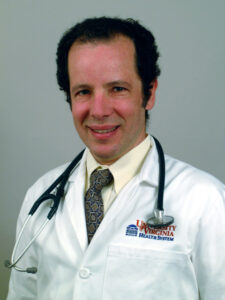Larry Borish, MD
Borish Lab
My laboratory’s current research focuses on the innate immunity-mediated mechanisms by which rhinovirus (RV) exacerbates asthma in children and adolescents. Viral infections, especially those caused by rhinovirus, are the most common cause of asthma exacerbations in this age group. Previous studies have argued that impaired innate anti-viral immunity and, as a consequence, more severe infections contribute to these exacerbations. Our current studies involve challenges of control, allergic rhinitis, and well-controlled asthmatic volunteers with RV-16. In these studies, both allergic rhinitic and asthmatic subjects demonstrated more severe cold symptoms. Asthmatic subjects demonstrated worsened asthma control and increased bronchial hyperreactivity in the setting of higher exhaled breath FeNO and blood eosinophils. These studies confirmed reduced expression of interferons and virus-specific pattern recognition receptors in both atopic cohorts. However, despite this defect in innate immunity, allergic rhinitis/asthmatic volunteers demonstrated reduced rhinovirus concentrations in comparison to controls. These observations argue for the presence of a compensatory mechanism to clear the infection and we suspect that that compensatory mechanism is mediated by the capacity of eosinophils and their derived cationic proteins to restrict respiratory viral infections, likely through their RNAse activity. Our current studies are focusing on mechanisms by which the RV infection drives the surge in T2 inflammation. We have demonstrated epigenetic modification of the allergic airway with reduced CpG methylation of the IL-25, IL-33, and TSLP genes and increased expression of these proteins after RV challenge. Planned studies include demonstrating the specific cellular source for these cytokines using single cell RNAseq and confocal microscopy to address the hypothesis that RV infection promotes differentiation of solitary chemosensory cells. Our challenge studies were also intriguing through their demonstration of protracted/recurrent symptoms 3-4 weeks after the challenge and we are eager to explore the impact of RV infection on airway differentiation and longer term airway remodeling.
asthma in children and adolescents. Viral infections, especially those caused by rhinovirus, are the most common cause of asthma exacerbations in this age group. Previous studies have argued that impaired innate anti-viral immunity and, as a consequence, more severe infections contribute to these exacerbations. Our current studies involve challenges of control, allergic rhinitis, and well-controlled asthmatic volunteers with RV-16. In these studies, both allergic rhinitic and asthmatic subjects demonstrated more severe cold symptoms. Asthmatic subjects demonstrated worsened asthma control and increased bronchial hyperreactivity in the setting of higher exhaled breath FeNO and blood eosinophils. These studies confirmed reduced expression of interferons and virus-specific pattern recognition receptors in both atopic cohorts. However, despite this defect in innate immunity, allergic rhinitis/asthmatic volunteers demonstrated reduced rhinovirus concentrations in comparison to controls. These observations argue for the presence of a compensatory mechanism to clear the infection and we suspect that that compensatory mechanism is mediated by the capacity of eosinophils and their derived cationic proteins to restrict respiratory viral infections, likely through their RNAse activity. Our current studies are focusing on mechanisms by which the RV infection drives the surge in T2 inflammation. We have demonstrated epigenetic modification of the allergic airway with reduced CpG methylation of the IL-25, IL-33, and TSLP genes and increased expression of these proteins after RV challenge. Planned studies include demonstrating the specific cellular source for these cytokines using single cell RNAseq and confocal microscopy to address the hypothesis that RV infection promotes differentiation of solitary chemosensory cells. Our challenge studies were also intriguing through their demonstration of protracted/recurrent symptoms 3-4 weeks after the challenge and we are eager to explore the impact of RV infection on airway differentiation and longer term airway remodeling.
